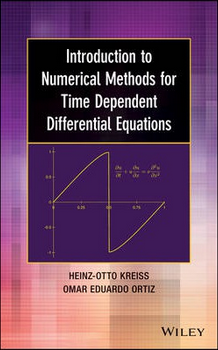
Introduction to Numerical Methods for Time Dependent Differential Equations
[BOOK DESCRIPTION]
Introduces both the fundamentals of time dependent differential equations and their numerical solutions Introduction to Numerical Methods for Time Dependent Differential Equations delves into the underlying mathematical theory needed to solve time dependent differential equations numerically. Written as a self-contained introduction, the book is divided into two parts to emphasize both ordinary differential equations (ODEs) and partial differential equations (PDEs). Beginning with ODEs and their approximations, the authors provide a crucial presentation of fundamental notions, such as the theory of scalar equations, finite difference approximations, and the Explicit Euler method. Next, a discussion on higher order approximations, implicit methods, multistep methods, Fourier interpolation, PDEs in one space dimension as well as their related systems is provided.Introduction to Numerical Methods for Time Dependent Differential Equations features: * A step-by-step discussion of the procedures needed to prove the stability of difference approximations * Multiple exercises throughout with select answers, providing readers with a practical guide to understanding the approximations of differential equations * A simplified approach in a one space dimension * Analytical theory for difference approximations that is particularly useful to clarify procedures Introduction to Numerical Methods for Time Dependent Differential Equations is an excellent textbook for upper-undergraduate courses in applied mathematics, engineering, and physics as well as a useful reference for physical scientists, engineers, numerical analysts, and mathematical modelers who use numerical experiments to test designs or predict and investigate phenomena from many disciplines.
[TABLE OF CONTENTS]
Preface xi
Acknowledgments xiii
Part I Ordinary Differential Equations And
Their Approximations
1 First-Order Scalar Equations 3 (20)
1.1 Constant coefficient linear equations 3 (7)
1.1.1 Duhamel's principle 8 (1)
1.1.2 Principle of frozen coefficients 9 (1)
1.2 Variable coefficient linear equations 10 (4)
1.2.1 Principle of superposition 10 (2)
1.2.2 Duhamel's principle for variable 12 (2)
coefficients
1.3 Perturbations and the concept of 14 (4)
stability
1.4 Nonlinear equations: the possibility of 18 (2)
blow-up
1.5 Principle of linearization 20 (3)
2 Method of Euler 23 (14)
2.1 Explicit Euler method 23 (3)
2.2 Stability of the explicit Euler method 26 (1)
2.3 Accuracy and truncation error 27 (2)
2.4 Discrete Duhamel's principle and global 29 (3)
error
2.5 General one-step methods 32 (1)
2.6 How to test the correctness of a program 32 (3)
2.7 Extrapolation 35 (2)
3 Higher-Order Methods 37 (18)
3.1 Second-order Taylor method 37 (2)
3.2 Improved Euler's method 39 (1)
3.3 Accuracy of the solution computed 40 (4)
3.4 Runge-Kutta methods 44 (4)
3.5 Regions of stability 48 (3)
3.6 Accuracy and truncation error 51 (1)
3.7 Difference approximations for unstable 52 (3)
problems
4 Implicit Euler Method 55 (10)
4.1 Stiff equations 55 (3)
4.2 Implicit Euler method 58 (5)
4.3 Simple variable-step-size strategy 63 (2)
5 Two-Step and Multistep Methods 65 (10)
5.1 Multistep methods 65 (1)
5.2 Leapfrog method 66 (4)
5.3 Adams methods 70 (1)
5.4 Stability of multistep methods 71 (4)
6 Systems of Differential Equations 75 (6)
Part II Partial Differential Equations And
Their Approximations
7 Fourier Series and Interpolation 81 (12)
7.1 Fourier expansion 81 (6)
7.2 L2-norm and scalar product 87 (3)
7.3 Fourier interpolation 90 (3)
7.3.1 Scalar product and norm for 91 (2)
1-periodic grid functions
8 1-Periodic Solutions of Time Dependent 93 (12)
Partial Differential Equations with Constant
Coefficients
8.1 Examples of equations with simple wave 93 (3)
solutions
8.1.1 One-way wave equation 93 (1)
8.1.2 Heat equation 94 (1)
8.1.3 Wave equation 95 (1)
8.2 Discussion of well posed problems for 96 (9)
time dependent partial differential
equations with constant coefficients and
with 1-periodic boundary conditions
8.2.1 First-order equations 96 (2)
8.2.2 Second-order (in space) equations 98 (1)
8.2.3 General equation 99 (1)
8.2.4 Stability against lower-order terms 100 (5)
and systems of equations
9 Approximations of 1-Periodic Solutions of 105 (14)
Partial Differential Equations
9.1 Approximations of space derivatives 105 (4)
9.1.1 Smoothness of the Fourier 108 (1)
interpolant
9.2 Differentiation of Periodic Functions 109 (1)
9.3 Method of lines 110 (5)
9.3.1 One-way wave equation 110 (3)
9.3.2 Heat equation 113 (1)
9.3.3 Wave equation 114 (1)
9.4 Time Discretizations and Stability 115 (4)
Analysis
10 Linear Initial Boundary Value Problems 119 (18)
10.1 Well-Posed Initial Boundary Value 119 (7)
Problems
10.1.1 Heat equation on a strip 120 (2)
10.1.2 One-way wave equation on a strip 122 (2)
10.1.3 Wave equation on a strip 124 (2)
10.2 Method of lines 126 (11)
10.2.1 Heat equation 126 (4)
10.2.2 Finite-differences algebra 130 (1)
10.2.3 General parabolic problem 131 (3)
10.2.4 One-way wave equation 134 (1)
10.2.5 Wave equation 135 (2)
11 Nonlinear Problems 137 (12)
11.1 Initial value problems for ordinary 138 (3)
differential equttons
11.2 Existence theorems for nonlinear 141 (4)
partial differential equations
11.3 Nonlinear example: Burgers' equation 145 (4)
A Auxiliary Material 149 (6)
A.1 Some useful Taylor series 149 (1)
A.2 "O" notation 150 (1)
A.3 Solution expansion 150 (5)
B Solutions to Exercises 155 (18)
References 173 (2)
Index 175

 新书报道
新书报道